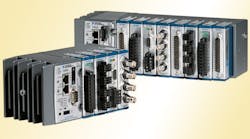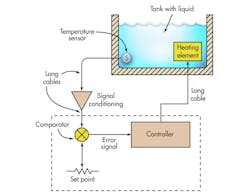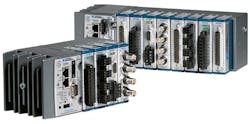Industrial control applications involve a monitoring function, a control function, or both. Some physical characteristic like temperature, pressure, light, or position usually is monitored. Some cases involve a measurement, meaning some instrumentation equipment is needed. Otherwise the monitoring results in just a “present” or “not-present” signal.
Data acquisition is an example of monitoring where multiple physical characteristics are detected or measured. This data is collected, stored, processed, and ultimately displayed. Data acquisition may not be involved in control operations, where the measured or monitored parameter becomes a feedback signal to effect them.
Related Articles
• Build A Color Printer For The Cost Of A B&W Model
• Alternating Relay/Duplex Controllers Ensure Equal Runtime
• 32-Bit Industrial Microcontrollers Come With Dev Tools
In control applications, some physical characteristic is changed. Devices like motors or valves are turned off or on or some other physical variable is modified. The state may be either off or on or may be a proportional variation such as speed. Many applications use a combination or monitoring and control operations, which can be classified as either open loop or closed loop control.
Open loop operations normally involve human monitoring and control. For instance, an operator may visually observe the temperature of the liquid in a tank. If the temperature drops below a certain minimum value, the operator manually turns on a heating element to increase the temperature to the desired value.
Closed loop control automates the temperature condition. A temperature sensor sends a signal to a controller that operates the heating element. Therefore, the temperature of the liquid is self-regulating without human intervention (Fig. 1). The set point is usually a voltage setting that specifies the desired temperature. It is compared to a signal from a temperature sensor that tells the actual temperature.
If the two signals are the same, no action is required. If a difference exists, an error signal is generated, initiating the turn-on of the heating element. As soon as the temperature reaches the desired level, the feedback sensor detects it and the controller shuts off the heating element. This is an example of on-off control. Continuous control would provide continuous power to the heating element and vary the current through it to maintain the temperature more closely.
The various parts of this system are often located remotely from one another. The set point source and the controller may be located together but the heating element and the temperature sensor may be some distance away. This means that connectivity is required, usually by wire. The result is the need for not only the wiring but also appropriate interfaces or a network to connect everything as desired. In the real world, multiple closed loop systems like this operate in parallel and may interact with one another.
The National Instruments CompactRIO system is a flexible way to implement such applications (Fig. 2). This modular platform includes an embedded controller, a reconfigurable FPGA, and a mix of I/O modules for sensors and controllers. Modules are available for temperature, strain, and motion monitoring and control. The embedded controller and FPGA are programmed via NI’s LabVIEW software.


